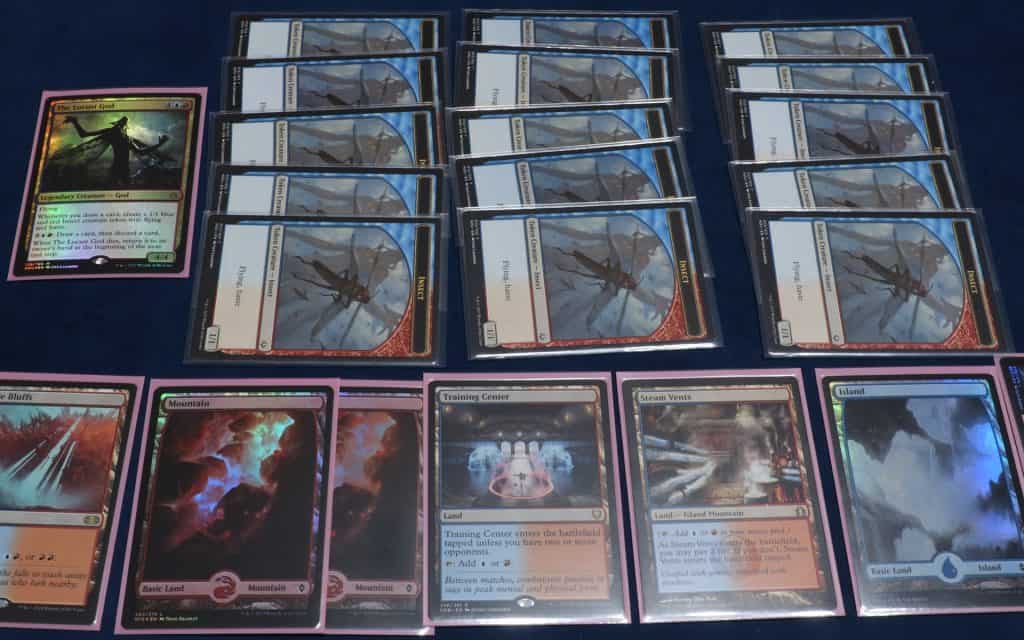Have you ever wanted to create a horde of creatures, watch the dread in your opponents’ eyes as they realize nobody at the table is holding a board wipe, then swing with dozens of attackers to take them all out simultaneously in a game of Magic: the Gathering (MTG)?
If so, token decks may be right for you. Side effects may include unbridled euphoria and outpourings of salt from your fellow Magic players.
Thanks to their many forms throughout Magic’s storied history, token decks have seen frequent play from casual circles to top tournament tables and can still be found in many formats today.
No format has kept this archetype more consistently popular than Commander, however, as token decks have enjoyed a loyal following since the format started taking off as EDH back in 2008.
What’s helped this archetype keep its legions of fans for all these years? In order to understand the why behind this deck’s popularity, you’ll need to begin by taking a look at what a token deck actually is and how it wins.
What is a Token Deck?
A token deck typically wants to create a large number of creature tokens, then either focuses on increasing their power and attacking with them to win the game through combat damage or using these large numbers alongside payoff cards to win the game through card effects.
The poster child for “go wide” creature strategies, token decks are often very difficult to answer once they start executing their game plan for a few reasons. First, there are a number of cards that allow you to double token production, meaning you’ll be putting out far more creatures than your opponents.
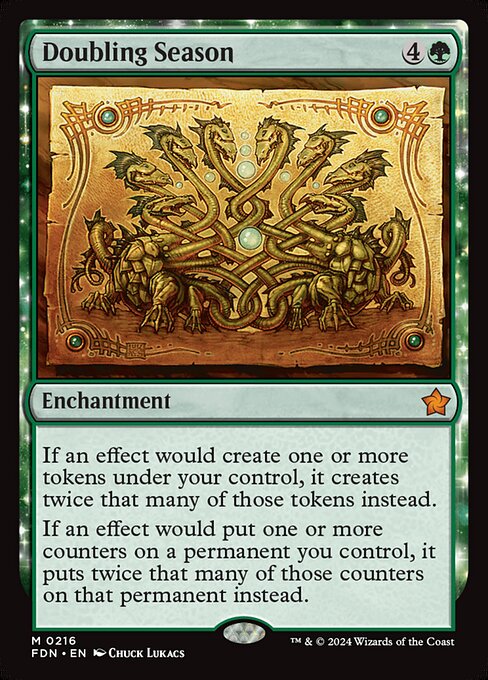
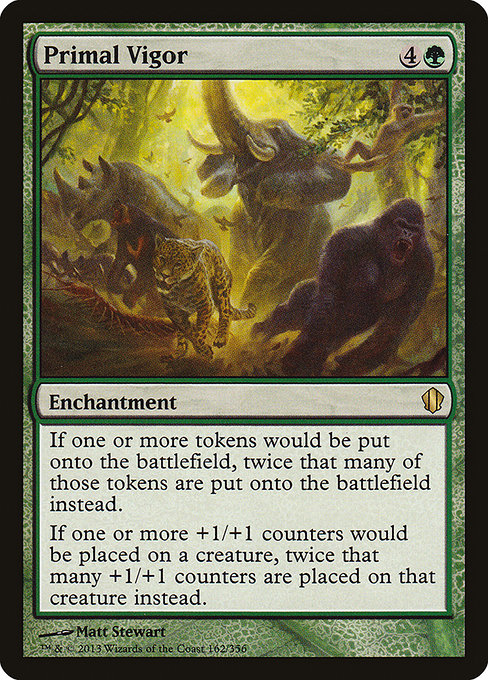
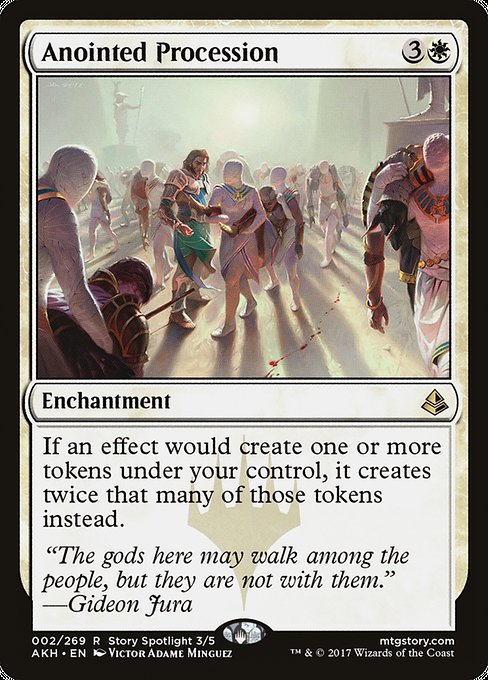
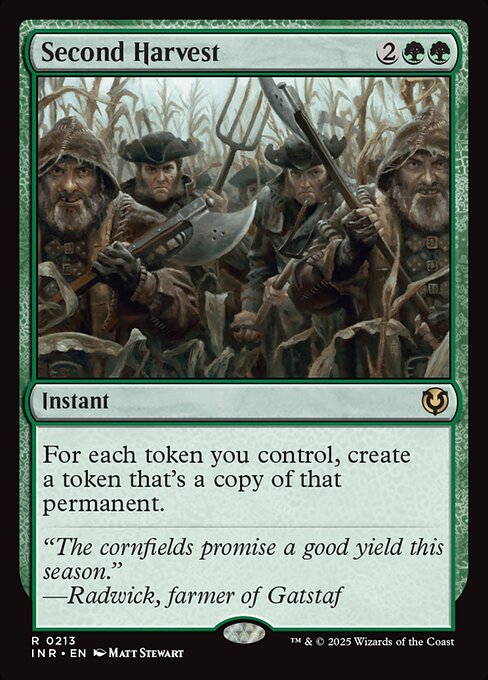
Once this large swarm of creatures is created, blocking them becomes a nightmare. Since blocking creatures can typically only block one attacking creature at a time, a token deck’s sheer numbers make quantity more important than quality, as they simply barge through several better creatures and force enough combat damage through to reduce their opposition’s life totals to 0.
Having large numbers also makes anthem effects (permanent abilities that boost the power and toughness of all creatures under your control) and one-time power boosts disproportionately powerful.

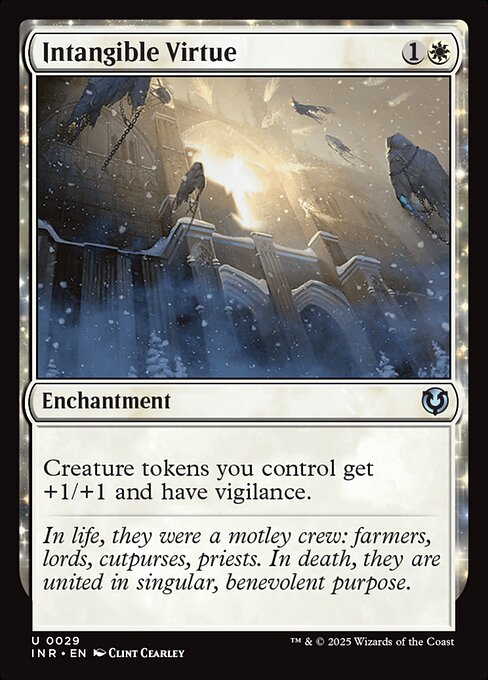
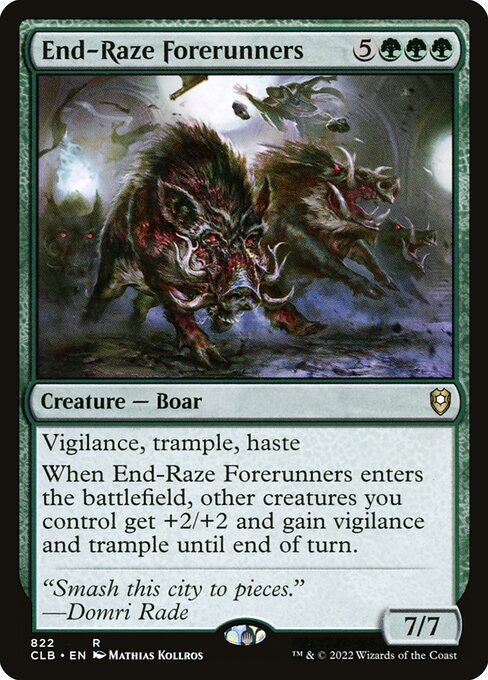
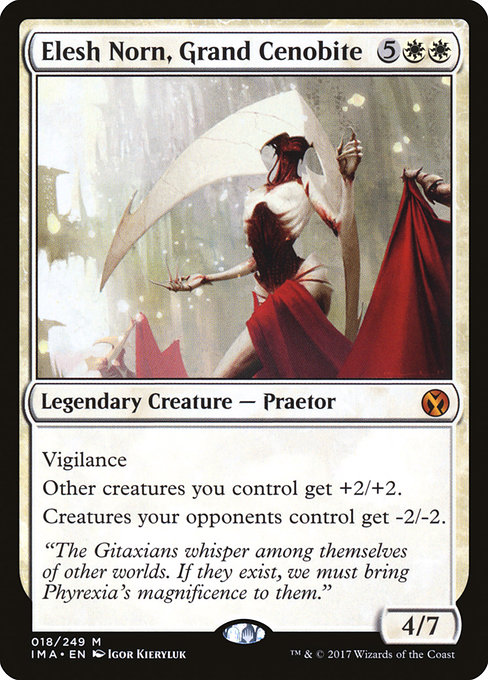
Suddenly, a board state that required 50 1/1s to attack a player for lethal damage might only require 20 or 30, putting a second or even third player in the crosshairs of the oncoming onslaught.
Combat damage isn’t the only way a token deck can win, however. Many token strategies prefer to use a token deck’s sheer numbers as fuel for powerful card effects to either to kill opponents outright, bleed them out as they try to preemptively deal with the growing swarm, or as cogs in a combo engine.
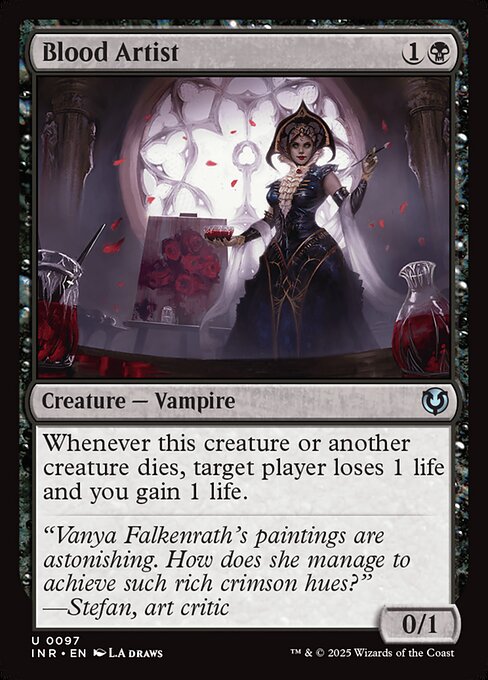
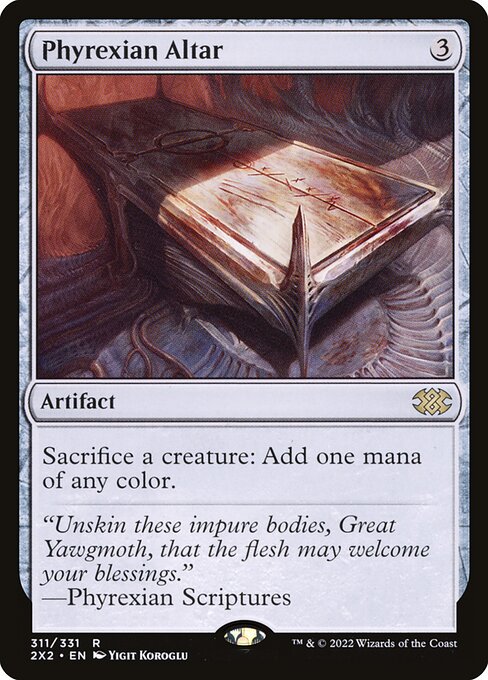
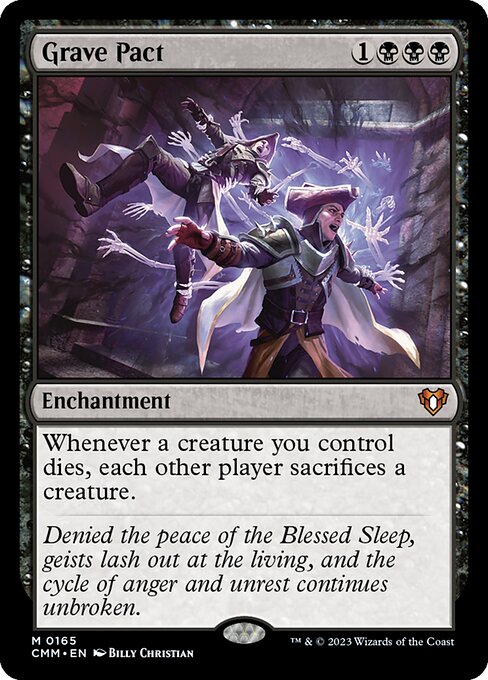

Some of the more dangerous token decks don’t have to pick a single route to victory either – they can attack the table on multiple axes, creating no-win situations for unwitting opponents who wait a little too long to address the swelling ranks of a token player’s creatures.
Like any strategy in Commander, however, finding the right legendary creature to put at the helm of your token deck is key. Fortunately, what used to be limited to green and green/white decks is open to a much wider selection of colors and color combinations today, so you can customize a token deck to fit your playstyle with ease!
What Makes a Good Token Commander?
Good token commanders in MTG must have at least 1 of the following 3 characteristics:
- The ability to generate a large number of tokens at a proportionally low mana and opportunity cost
- Easily repeatable token generation
- Strong supporting effects for tokens that justify not being able to create tokens
Good token commanders also can have the following traits in conjunction with the above:
- Fast, accessible payoffs for creating your tokens, such as giving them haste, boosting their power, or gaining effects when they die
- Potential for establishing infinite combos with your tokens
- Miscellaneous useful effects
Many of the strongest token commanders have multiple traits from the lists above and contain access to green and/or white cards, as these colors have the most powerful support cards for token strategies, many of which were shown earlier.
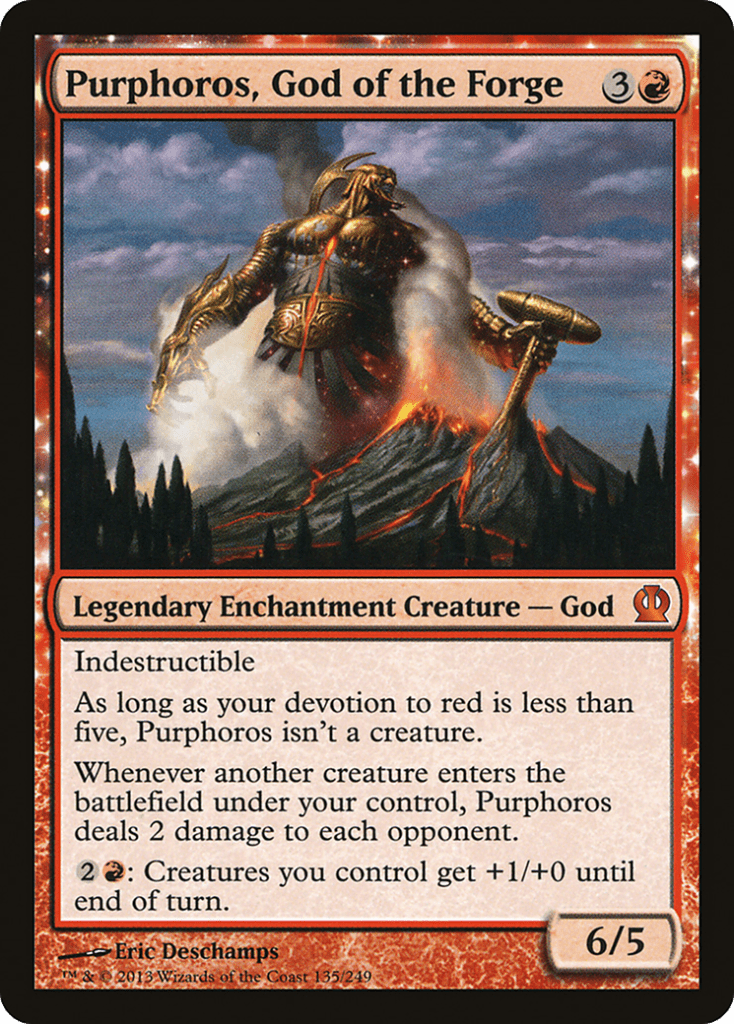
Some would also argue that a good token commander can always get by without the ability to generate tokens if it has a strong enough payoff like Purphoros, God of the Forge, and there’s plenty of evidence that aligns with that school of thought.
Despite this, I rarely consider cards that strictly deal in nontoken payoffs “token commanders” because they don’t have any focus on tokens, the backbone of any token deck’s win conditions!
Furthermore, many payoff effects for tokens, such as power/toughness boosts and effects that trigger when creatures die, are only useful at specific points in the game, often when you’re fully set up or winning.
This makes the benefit of these abilities always being available in your Command Zone a bit of a waste on their own, as a payoff is worthless if you can’t make any tokens to take advantage of it.
This doesn’t mean you can’t put legendary creatures like Jazal Goldmane at the helm of a token deck in Commander – you can and your deck will likely see some success through always having a way to close the game.
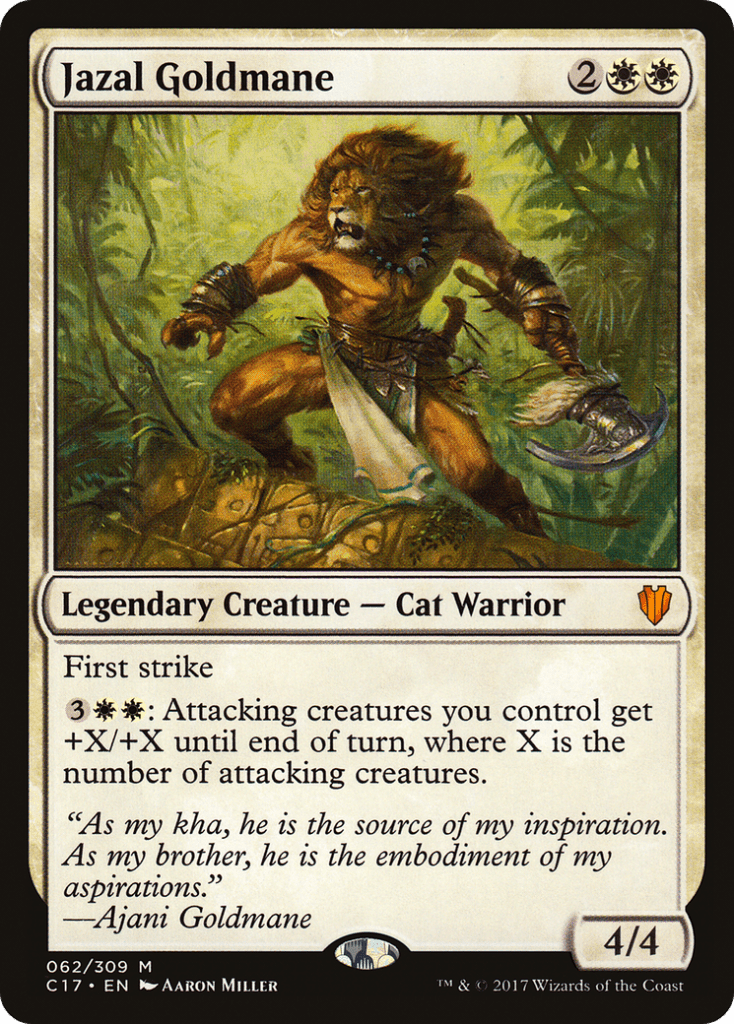
That said, Jazal Goldmane will also do well in any deck that wants to amass lots of efficient creatures, meaning this commander isn’t really focused on tokens or token strategies, and is decidedly mediocre if you haven’t put any token creatures into play yet or after a board wipe like Wrath of God destroys them all.
So now that we know what the traits of good token commanders in MTG are, which ones are the best? Let’s have a look.
Note that not all color combinations will be represented, but any that contain legendary creatures that directly enable a strong token strategy as their primary focus (using at least 1 of the first 3 criteria above) will be discussed.
MTG’s Best Token Commanders in EDH (Commander)
Best Green Token Commanders (Titania, Protector of Argoth and Nemata, Grove Guardian)

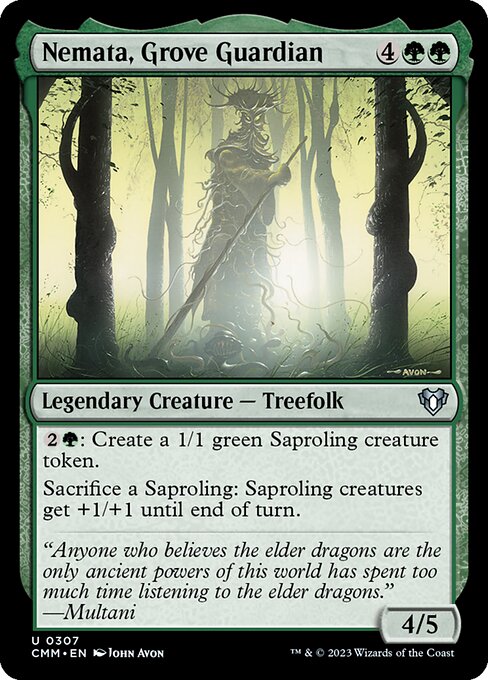
Mono-green token decks don’t have a lot of good legendary creatures dedicated to amassing tokens, which is surprising since green is one of the two colors most known for this strategy. The ones that excel in this area, however are powerhouses to be reckoned with.
Titania, Protector of Argoth is a pretty unusual card, rewarding a seemingly unintuitive play pattern by giving you huge 5/3 creature tokens in exchange for your lands. While green is the color best known for mana ramp, the reins on its ability to destroy lands have been pulled back dramatically in recent years.
Lands themselves, on the other hand, frequently have ways to sacrifice themselves, and cards like Wave of Vitriol and Zuran Orb can make instant armies while Titania is out. Mix in some recursion through cards like Splendid Reclamation and Crucible of Worlds, and you can easily ramp up your mana to do it all again.
Nemata, Grove Guardian, while expensive for a commander, also has the potential to be a huge threat at any point beyond the midgame as both token generator and payoff.
When attacking, you can sacrifice blocked Saprolings for free to boost all the other Saprolings that weren’t blocked before damage is applied to your opponent. This allows you to net several extra points of power across a token army and push through the last damage you need for a player kill with ease.
Best White Token Commanders (God-Eternal Oketra, Prava of the Steel Legion, and Darien, King of Kjeldor)
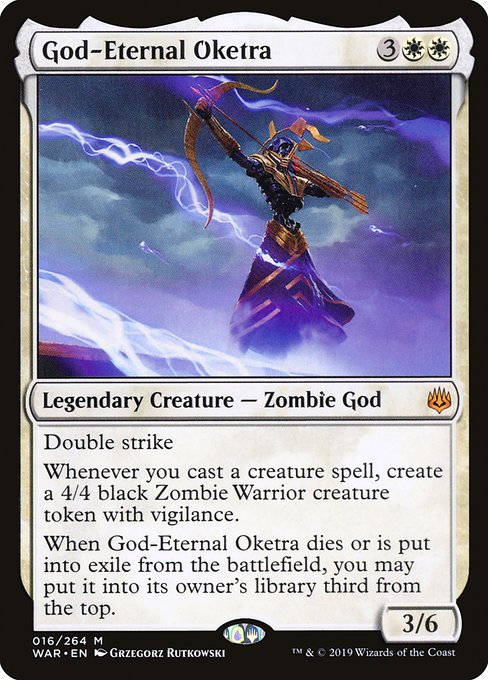
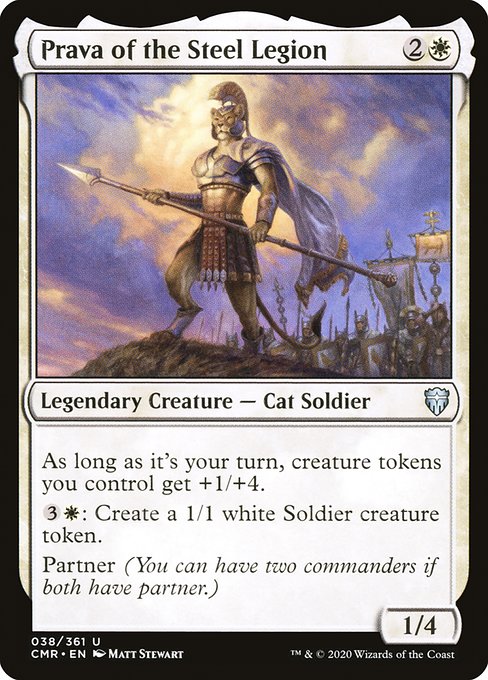
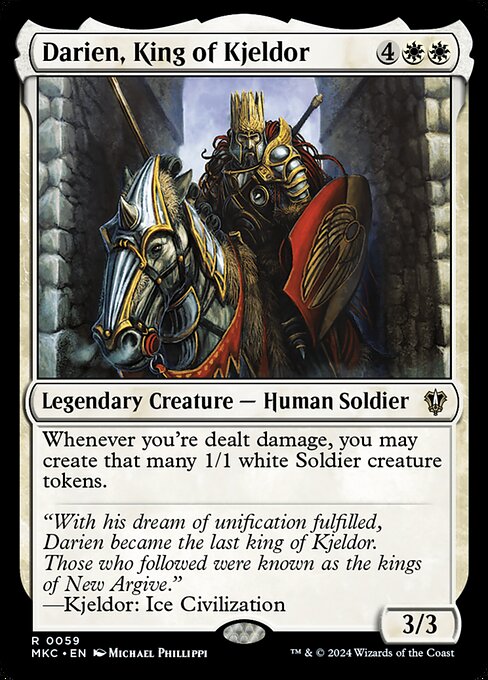
Mono-white token decks can be built a lot of different ways, as represented by the wide array of effects of these legendary creatures. If you just want extra mileage out of your creatures (or to abuse cards like Whitemane Lion to their fullest, God-Eternal Oketra has you covered.
Darien, King of Kjeldor is one of the most unique commanders in this space, requiring a balance of life gain effects along with ways to inflict damage on yourself to transform your life total into an army. Paired with cards like Ankh of Mishra or Dingus Staff, Darien’s ability can get out of hand quickly.
Unfortunately, 6 mana is a huge ask for an initial casting of this commander, but that should provide ample time to pad your life total, giving you more fuel to grow your army once the right time arrives.
Prava of the Steel Legion offers some of the highest flexibility among white legendary creatures for token decks, as you can pair it with another legendary creature that has partner to shore up weaknesses or broaden strategic options.
Giving +1/+4 to all creature tokens will make them very hard to kill in combat as well, which makes up for the steep 4 it costs to have Prava make a 1/1 for you. Fortunately, there are far more efficient ways to create tokens in white, so you’ll only need to overpay for your 1/1s in emergencies.
Best Blue Token Commanders (Talrand, Sky Summoner, Deekah, Fractal Theorist, Sai, Master Thopterist, and Orvar, the All-Form)
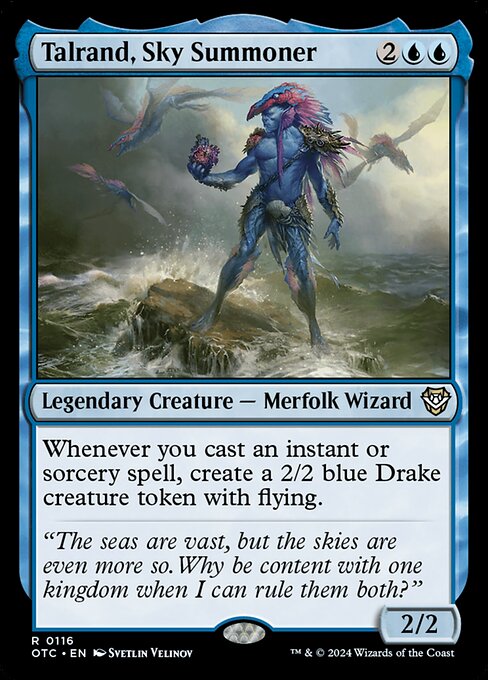
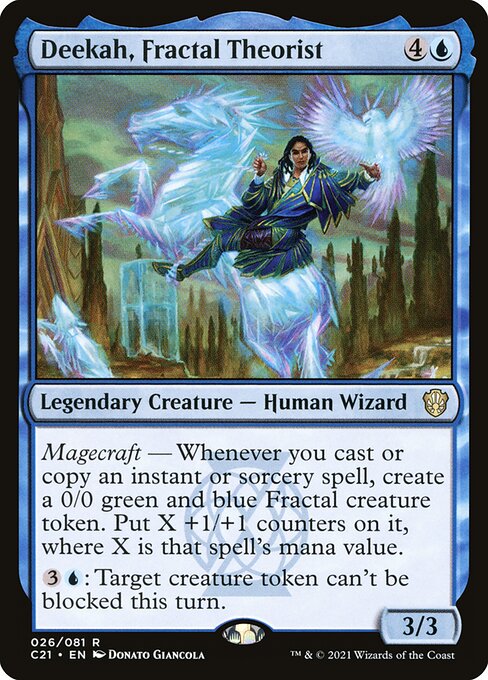
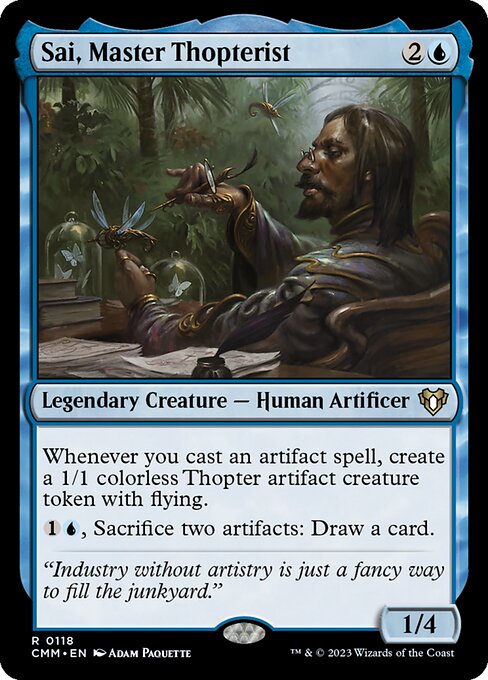
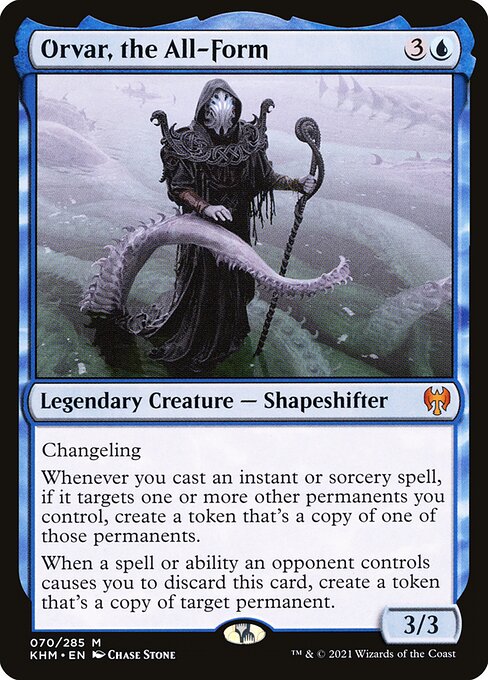
Most blue token commanders follow a very similar formula for deck construction – play a certain type of spell, get a creature token. Talrand, Sky Summoner has been the go-to in this design space for years, as its 2/2 drakes have built in evasion, but Deekah, Fractal Theorist can force damage through in a pinch by making big tokens unblockable as well.
Sai, Master Thopterist is the most flexible among legendary creatures with this play pattern, as there are plenty of strong artifact-centric strategies that synergize with its effects for building an army or drawing cards as the situation warrants.
But if you want something truly wild to build around, Orvar, the All-Form is one of the most fascinating card designs I’ve seen in a while. You can make token copies of any of your cards, including lands, artifacts, enchantments, creatures, or even planeswalkers! Orvar also has Changeling, giving it all creature types, so any tribal token strategies work with them as well.
If you want to see an Orvar deck in action, I highly recommend watching this episode of Extra Turns, where Josh Lee Kwai showcases some of the the cool stuff an Orvar deck can do.
Best Black Token Commanders (Marrow-Gnawer and Ghoulcaller Gisa)
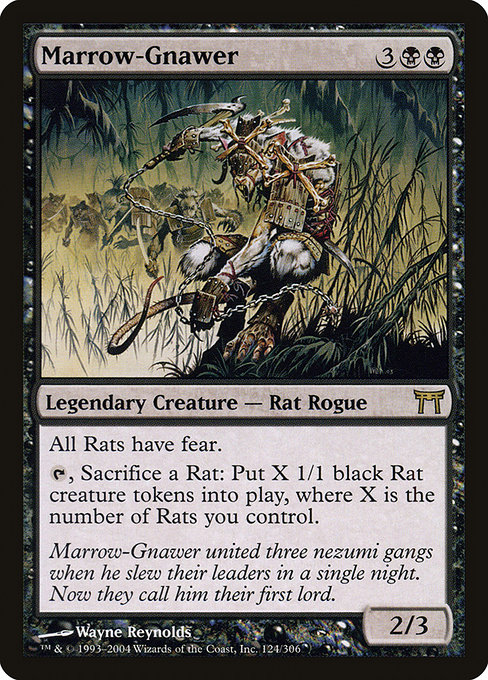
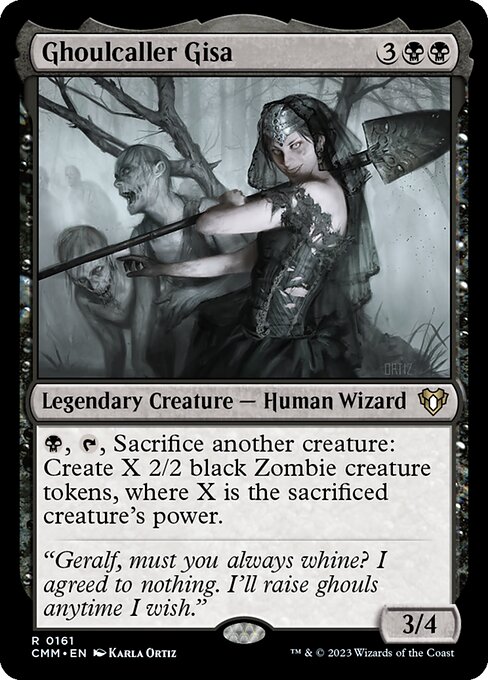
There’s not a lot to say about mono-black token decks – black simply has the most hoops to jump through to make a token strategy viable in Commander due to limited token support cards, few ways to give tokens haste, and usually requiring effects that tap your commander to mass produce tokens, adding an extra turn to the buildup process.
This becomes extra apparent once you see how Marrow-Gnawer and Ghoulcaller Gisa play very similarly to one another; each wants to turn a big creature into a harder hitting swarm of smaller creatures.
Both legendary creatures also tend to excel in tribal decks, though Ghoulcaller Gisa is a bit more flexible, allowing you to sacrifice any big creature to raise your army of the living dead. Marrow-Gnawer gets extra props for giving all your Rat tokens fear, giving you a payoff on the same card as your token generator.
Best Red Token Commanders (Krenko, Mob Boss, Krenko, Tin Street Kingpin, and Magda, Brazen Outlaw)
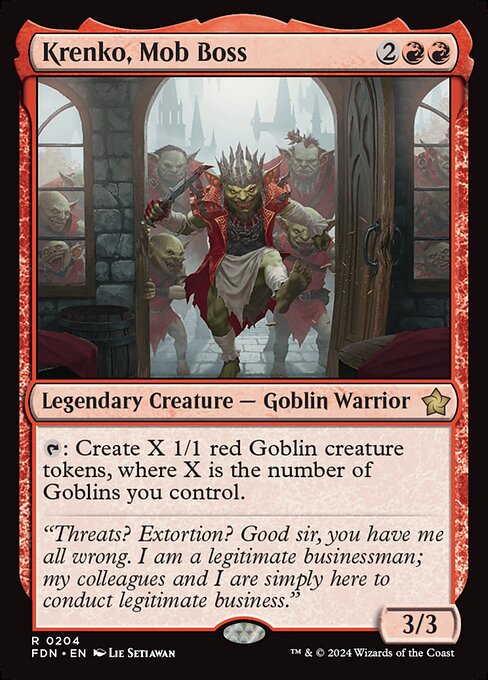
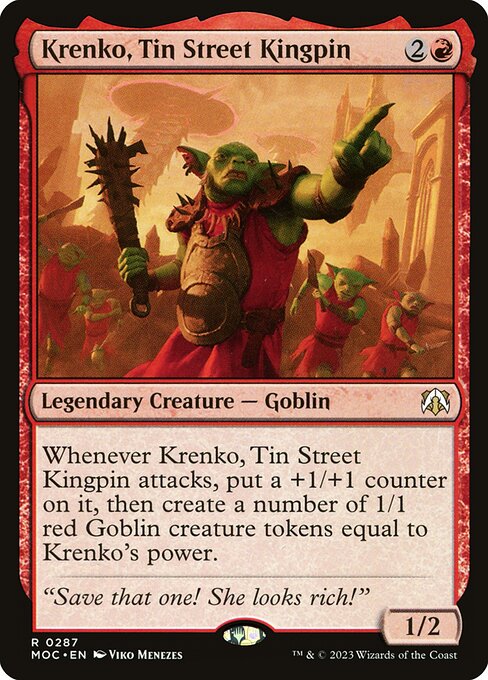
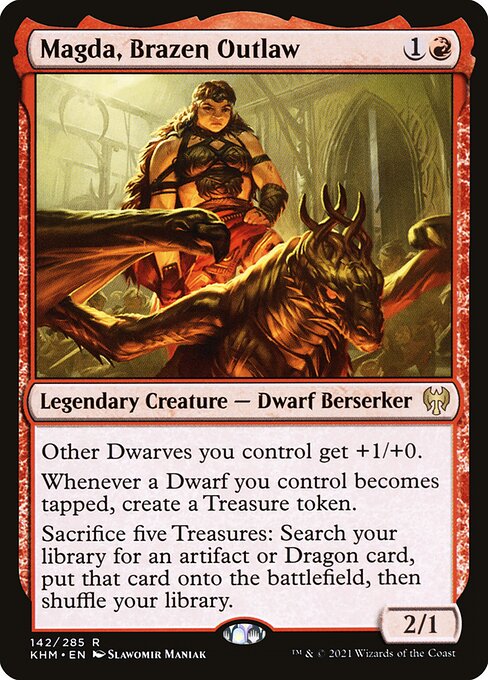
Red token decks share many of the same problems faced by black token decks, but can compensate for this due to the array of cards red has to give all creatures haste. Haste enablers are especially prominent in Goblin decks, which can easily become overwhelming with Krenko, Mob Boss or Krenko, Tin Street Kingpin at the helm.
Magda, Brazen Outlaw decks favor a different tribal strategy, but your Dwarves will be focused on making Treasure tokens rather than Dwarf tokens.
Treasures are useful because they can accelerate your mana in a pinch, or you can use Magda’s payoff effect to find expensive artifacts or Dragons to close the game with, opening up a cool token play pattern that is a breath of fresh air after years of Krenko and Purphoros, God of the Forge combo killing tables by generating a zillion goblins.
Oh, and an honorary mention to Godo, Bandit Warlord + Helm of the Host and Kiki-Jiki, Mirror Breaker + Zealous Conscripts. These legendary creatures tend to be very singularly focused in how they win games, but both make undeniably powerful decks.
Godo also sees a lot of cEDH play, so despite not being a “token commander”, it would have felt wrong not to mention his prowess in the field here.
Best Selesnya Token Commanders (Rhys the Redeemed, Trostani Discordant, and Emmara, Soul of the Accord)
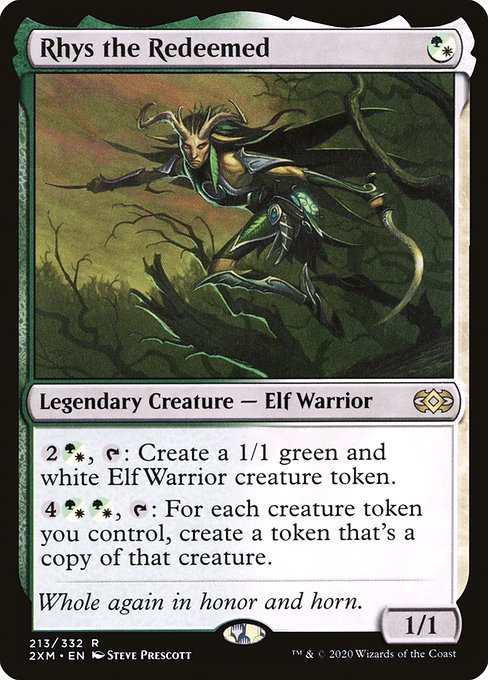
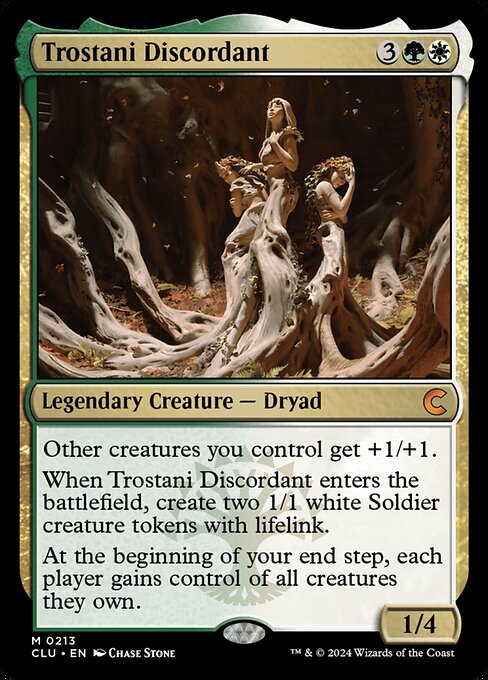
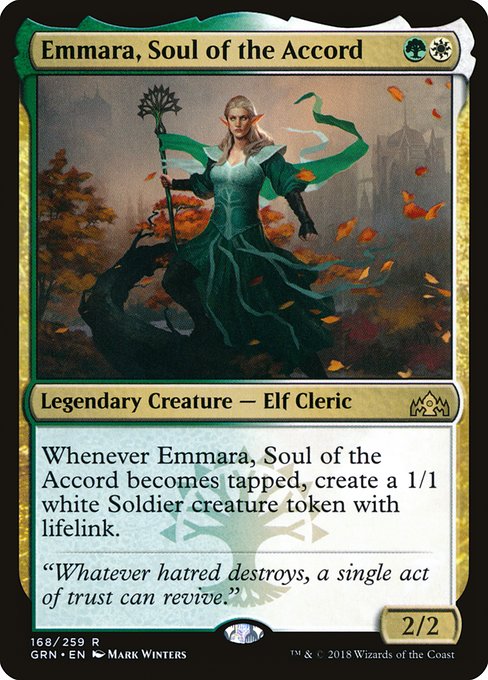
Selesnya was really the first optimized selection of colors for token decks in Commander (then EDH), and credit for that falls squarely on Rhys the Redeemed. Being able to play a commander on turn 1 is a big deal, and having an impactful effect through token doubling in the late game can easily help you break out of a stalemate on the board.
Emmara, Soul of the Accord offers a more inexorable approach to token creation, allowing you to take advantage of ways to untap her on opposing turns or repeatedly tap and untap her with specific card effects like Paradise Mantle, Reconnaissance, and Staff of Domination. Factor in a low mana cost, and you’ve got an all-star capable of helping you at all stages of the game.
Finally, we have Trostani Discordant, a weird card that definitely lives up to its “discordant” name. Trostani gives you 5 power across 3 bodies, which isn’t bad at 5 mana, but miserable if you have to recast it with commander tax. The anthem effect is nice, but the ability to shut down decks that like to steal creatures is arguably more useful in many playgroups.
Each of these 3 abilities is good for a token deck, but none really excel in a specific area of the strategy, and yet this card still manages to do a lot of work as a commander. If I hadn’t seen it myself on multiple occasions, I wouldn’t have thought this a stellar commander for token decks simply by reading it, but the sum of its potential greatly exceeds its parts.
Best Dimir Token Commanders (The Scarab God, Oona, Queen of the Fae, and Wilhelt, the Rotcleaver)
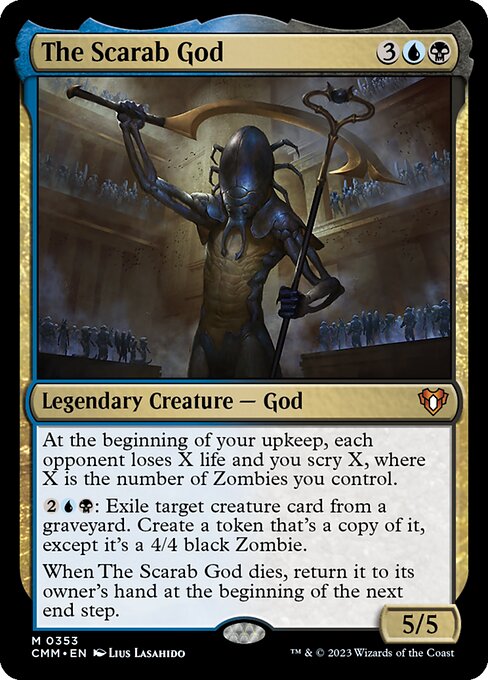
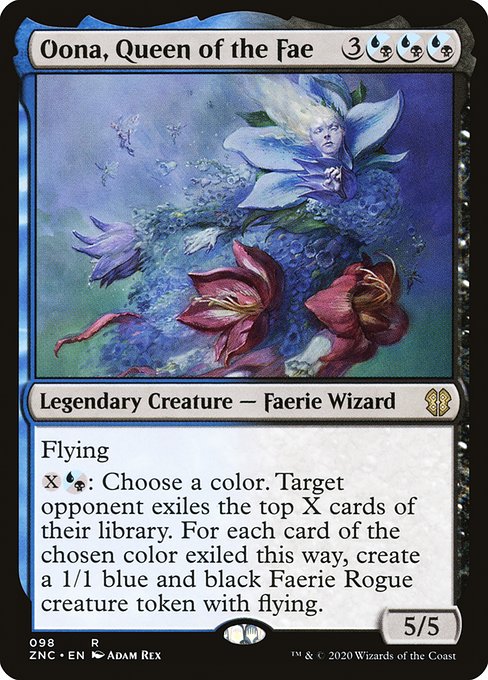
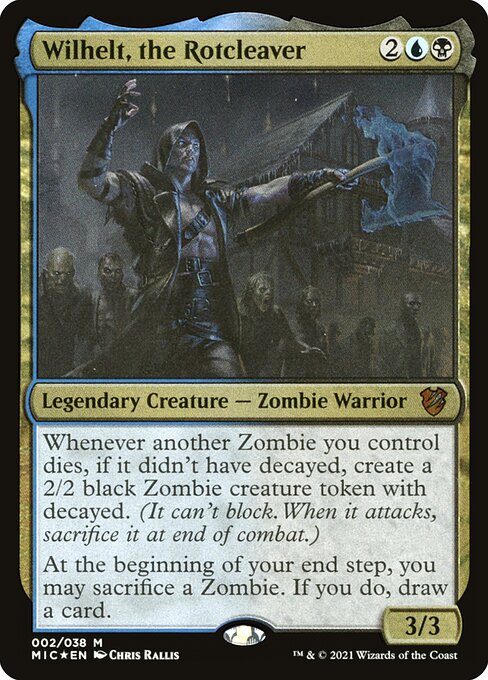
Oona, Queen of the Fae may not be a super popular commander nowadays, but in years past, it was common to see this powerful creature heading mill decks, Faerie decks, and Dimir good stuff builds due to her efficient ability to take cards away from combo decks and generate silly amounts of flying tokens from monocolor decks.
Today, her spot has been usurped by The Scarab God, a ridiculous creature that gives you far more value for a lower mana cost and dodges most commander tax. Powerful token generation fueled by full graveyards makes The Scarab God a no-brainer for mill decks, but the tokens themselves frequently win games on their own merits.
Sure, 4 mana is considered a little above average for reanimation strategies, but once you start pairing this commander with Training Grounds and Cabal Coffers, you can create several potent tokens a turn, then use your new Zombies to filter through the top of your deck during your upkeep to find the card you need to close the game.
In short, The Scarab God is simply the best card in these colors for a variety of deck archetypes, and tokens are no exception since you get token generation and payoff in an efficient 5/5 body for 5 mana.
If you’re looking for a token commander with a little more resilience, however, Wilhelt, the Rotcleaver might fit the bill. Clearly aimed at Zombie tribal decks, it doubles the number of board wipes needed to clear your battlefield, and can turn unwanted Zombies into more cards.
Last I recall, payoff and token production on the same commander is a pretty good combination of effects. The fact that the token production is used to invalidate or mitigate a lot of creature removal is just icing on the cake – especially when you consider Wilhelt’s ability works with all Zombies, not just nontoken creatures like most effects in this vein.
Best Gruul Token Commanders (Phylath, World Sculptor, Chishiro, the Shattered Blade, Jolene, the Plunder Queen, and Omnath, Locus of Rage)
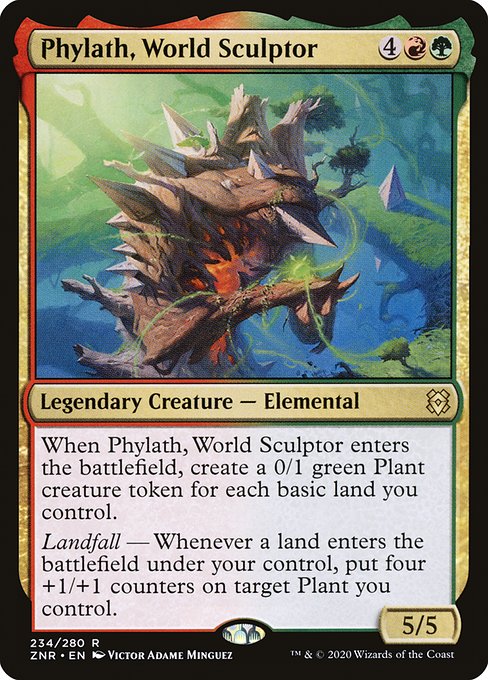
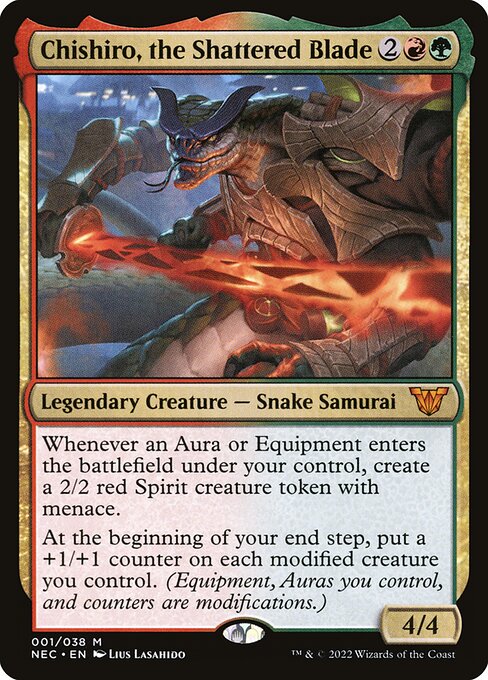
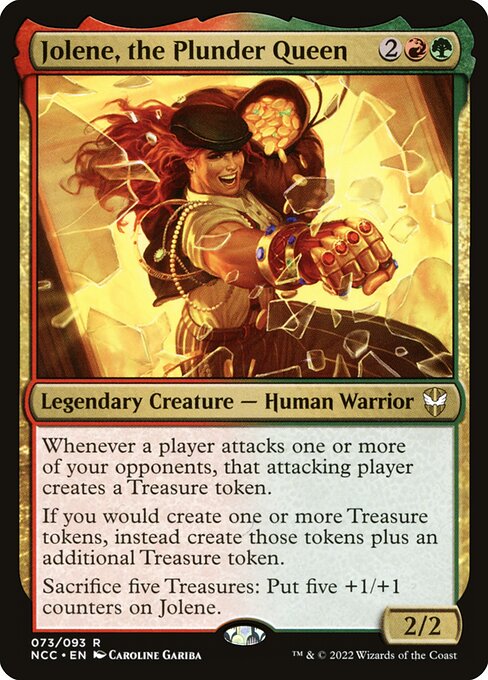

Do you like overrunning your opponents with Avenger of Zendikar? Would you like the ability to do it from the command zone? Phylath, World Sculptor is just what you’re looking for.
Admittedly, Phylath pushing you toward basic lands during deck construction is a bit annoying, but the massive number of creatures it makes and the ability to hand out 4 power to a Plant creature of your choice is incredibly strong, and turns late game mana ramp into a lot of potential pain for your opponents.
Omnath, Locus of Rage follows a similar play pattern, but just gives you a 5/5 for each land you play. The more Elemental tokens Omnath brings out, the more it starts to create a stranglehold over the table, as a careless board wipe could accidentally take a player out of the game.
7 mana is really expensive for a commander, however, and 6 isn’t much better from Phylath, so I’d recommend playing a lot of ramp and card draw if you elect to build decks around these legendary creatures.
If you’d prefer to try an angle with red and green that doesn’t revolve around mana ramp, Chishiro, the Shattered Blade does a very good job of rewarding use of Aura and Equipment cards.
Getting 2/2s simply for playing Magic is a strong ability on its own, and opens up options for mana ramp, Voltron (making 1 creature super strong through powerups), Curses like Curse of Opulence for table politicking, and several other cool, unique effects that Auras can bring to the table as you build a token army.
On the other hand, if you want to lean harder into mana ramp, Jolene, the Plunder Queen is your gal. While she won’t always double treasure production, many cards like Parallel Lives that are known for doubling creature tokens will also double treasure tokens, so a lot of popular token support is still open when deckbuilding.
Red also deals a lot with treasure, offering you support through cards like Xorn, Dockside Extortionist, and even the aforementioned Magda, Brazen Outlaw. Then you can lean into making Jolene a threat that can kill players with commander damage, or just play big, splashy finishers to bludgeon your opponents into submission.
Best Simic Token Commanders (Adrix and Nev, Twincasters and Esix, Fractal Bloom)
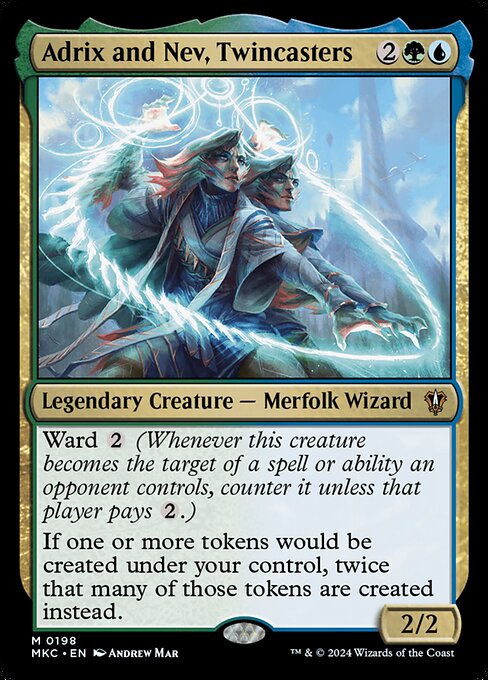
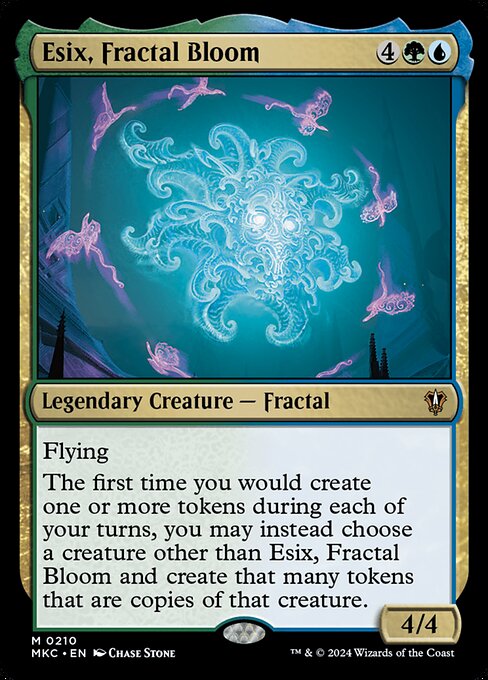
Adrix and Nev, Twincasters is Parallel Lives on a 2/2 with some protection from targeted removal. Opening up access to blue lets you use Sakashima of a Thousand Faces to quadruple your tokens by copying your commander, top notch card draw, and powerhouse spells like Cyclonic Rift to clear the path for your token army.
Esix, Fractal Bloom requires considerably more setup than Adrix and Nev, but the payoff can lead to some fun shenanigans. Making several Craterhoof Behemoths, Coiling Oracles, Elvish Champions, or Man-o’-Wars off a Rite of Replication, Arachnogenesis, or Spell Swindle will often propel you far ahead of the table if you can pull it off.
Best Orzhov Token Commanders (Daxos the Returned, Elenda the Dusk Rose, Teysa Karlov, and Thalisse, Reverent Medium)
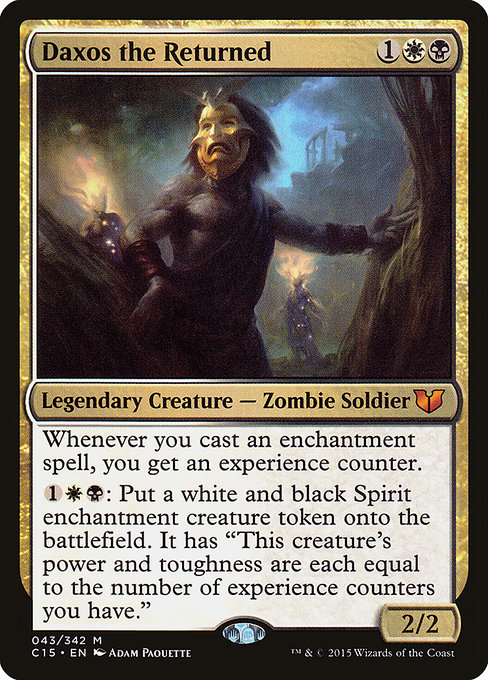
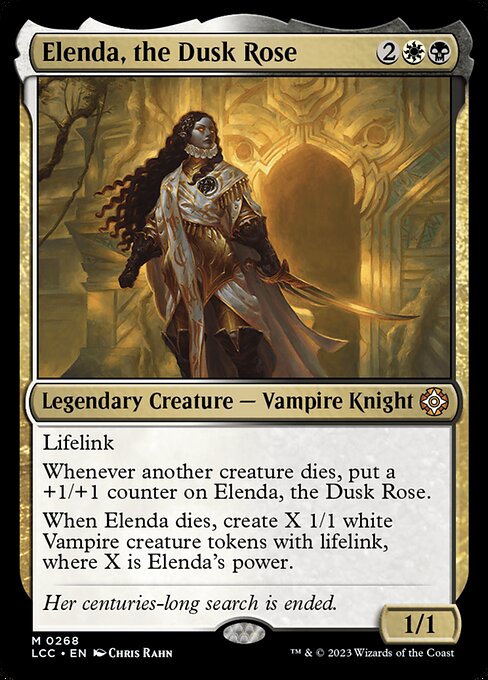
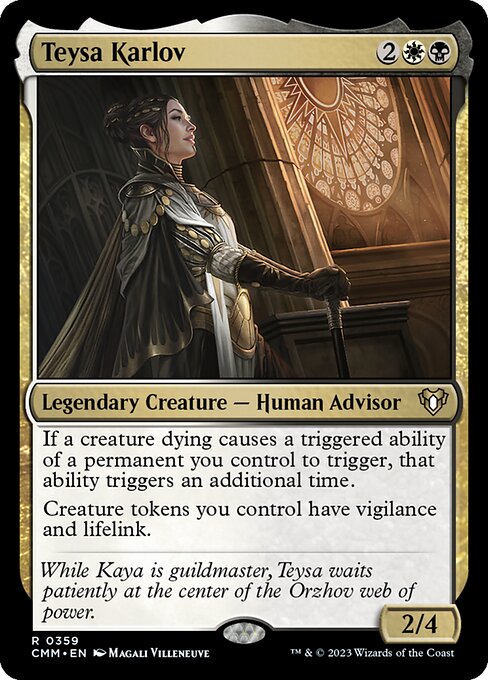

Orzhov has a surprising array of legendary creatures that allow you to build a variety of different token decks. While getting benefits from creatures dying is the default Orzhov strategy, as seen with Elenda, the Dusk Rose and Teysa Karlov, even these legendary creatures go above and beyond to either support creature tokens directly or develop a powerhouse creature that can neither be left unchecked nor allowed to die.
Thalisse, Reverent Medium looks like another Anointed Procession variant, but rather than making exact token doubles on your turn, she makes 1/1 Spirits with flying. This is very much a net positive, as tokens with evasion are able to end games through combat much more easily than those without, and best of all, Thalisse doesn’t care what type of tokens you created earlier in the turn!
As if we didn’t have enough reasons to run Smothering Tithe, am I right?
Speaking of powerful enchantments, Daxos the Returned is another in the vein of commanders who reward you for building a specific deck then simply playing a game of Magic. Getting a 5/5, 8/8, or 10/10 for 3 mana is no joke, and surprisingly easy to do as long as Daxos can get a few turns of face time on the battlefield.
Best Izzet Token Commanders (The Locust God and Brudiclad, Telchor Engineer)
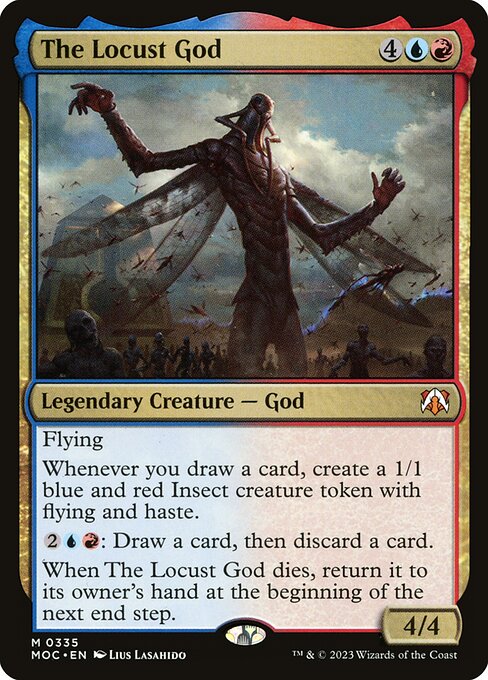
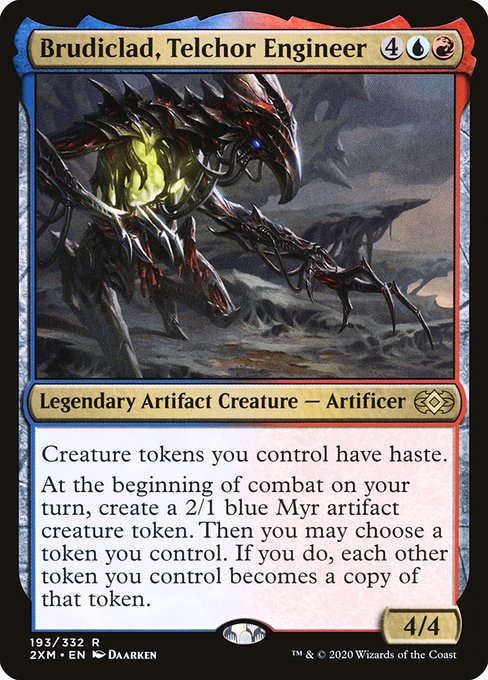
Izzet has a couple different options for building token decks, and like Simic token decks, they cater to a couple very different playstyles. If you’re looking for straightforward setup and execution, The Locust God gives out free 1/1 flying tokens with haste with every card you draw.
Wheel of Fortune, Windfall, and Brainstorm are but a few of the common wheels (cards that cause everyone to discard their hand and redraw a full one) and low mana value card draw engines that get this swarm humming, and if you run out of quick card draw options, 4 mana will let you loot an extra card in your deck to try and find the next one.
Brudiclad, Telchor Engineer requires a lot of the same setup steps as Esix, Fractal Bloom. Brudiclad’s advantages are that it gives all tokens haste and it produces one on its own each turn, so you’re able to more quickly execute attack plans in exchange for not being able to copy effects that trigger when a creature enters the battlefield.
Best Golgari Token Commanders (Hapatra, Vizier of Poisons, Chatterfang, Squirrel General, Lathril, Blade of the Elves, and Slimefoot, the Stowaway
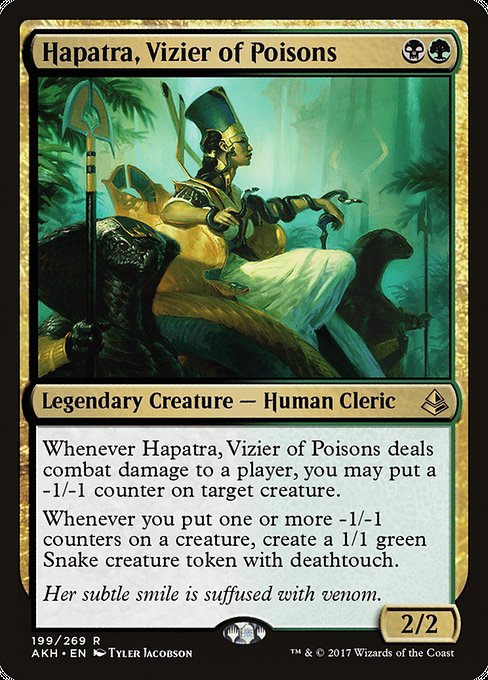
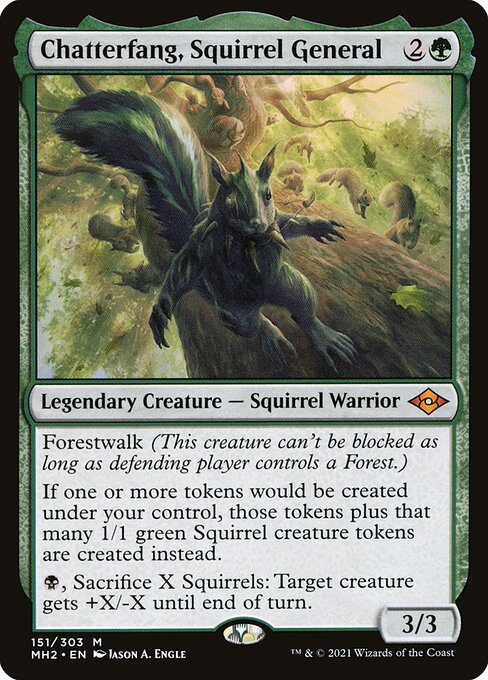
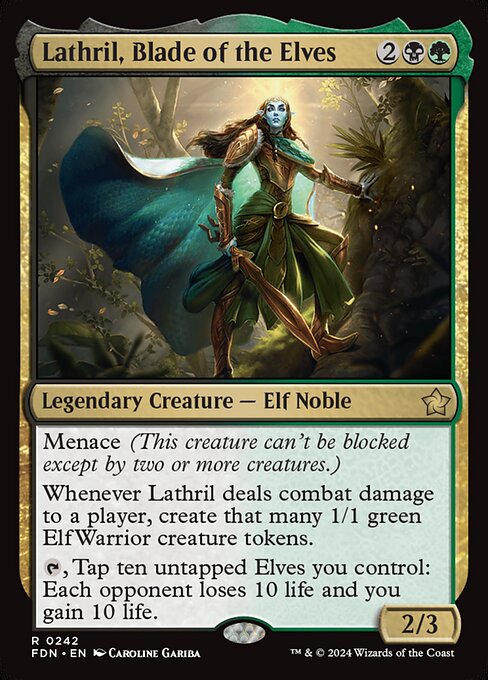
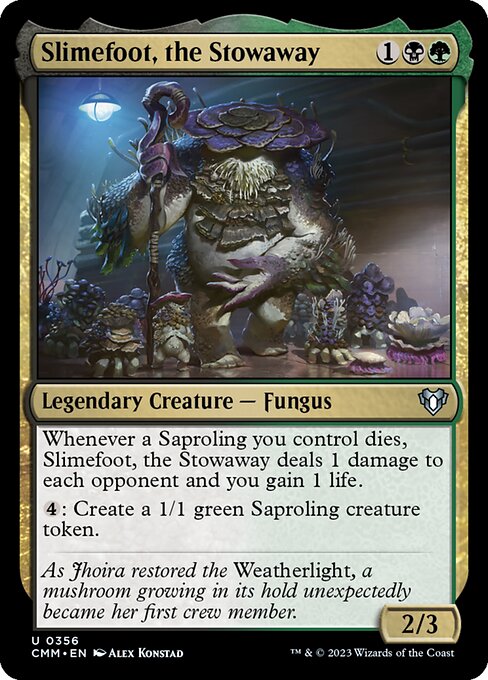
Golgari offers what could arguably be the most varied selection of token strategies among color combinations. There’s a little something for fans of tribal decks, token doublers, combos, and attrition.
Lathril, Blade of the Elves is the Golgari Elf commander that deck has been looking for since Rhys the Exiled. Between the variety of anthem effects among Elf creatures and Menace requiring two creatures to block Lathril, it’s easy to generate several tokens a turn in many board states.
Attackers are being held at bay by a Ghostly Prison? Just tap 10 of them along with Lathril to deal a ton of damage to your opponents and gain some life. Repeat as needed – bonus points for using Seedborn Muse to aid and abet.
Chatterfang, Squirrel General was one of the most exciting cards of Modern Horizons 2 for a couple reasons. First, it’s a good commander for Squirrel decks. Second, it can make a silly number of tokens, and use them to either swarm opponents or clear problematic opposing creatures.
The versatility of this card is pretty unreal, and having an excuse to play the Earthcraft + Squirrel Nest combo is never a bad thing either – especially when you get to generate twice as many infinite tokens with Chatterfang!
Hapatra, Vizier of Poisons and Slimefoot the Stowaway play the attrition game well, but go about it in very different ways. Hapatra’s synergy with -1/-1 counters helps ensure you have the most creatures on play at all times, and since her Snake tokens have Deathtouch, they also serve as an excellent deterrent to opponents looking to exact retribution.
Slimefoot aims for more of an Aristocrats theme (a deck that seeks to slowly deal damage to opponents and raise your life total when your creatures die), and can become very dangerous with all the Saproling support that exists across MTG’s history. Sprout Swarm is arguably one of your strongest cards for this deck, as it can singlehandedly raise a Saproling army at instant speed.
Best Boros Token Commanders (General Ferrous Rokiric and Osgir, the Reconstructor)
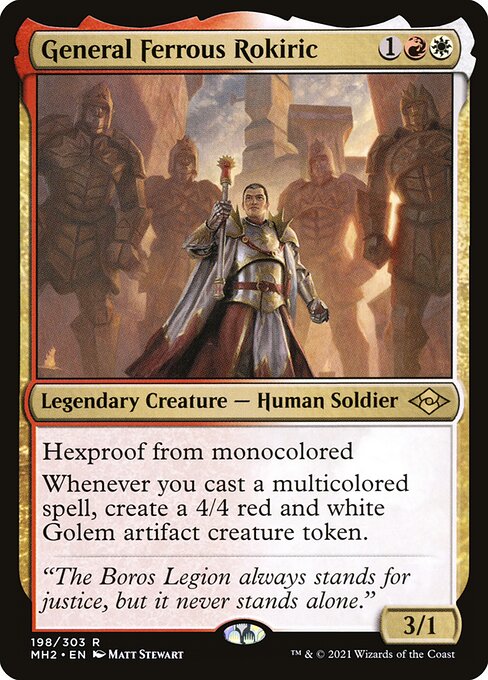
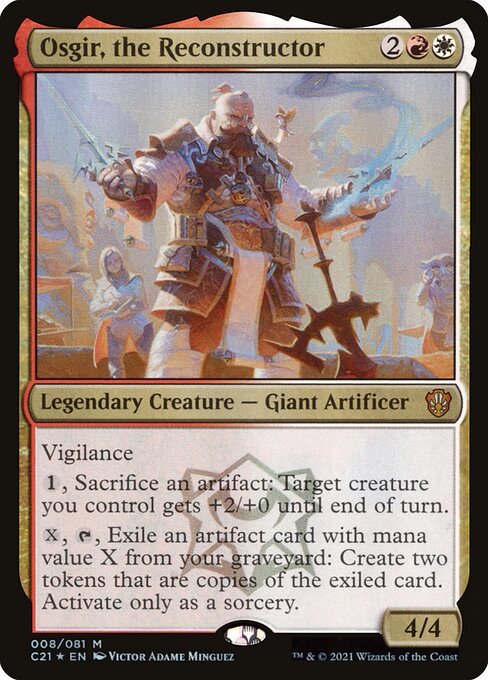
I’ll be honest – I wasn’t expecting to find a decent Boros token commander, let alone two, but both General Ferrous Rokiric and Osgir, the Reconstructor both deliver excellent experiences for token enthusiasts in very different ways.
Rokiric’s effect emphasizes “multicolor matters”, giving you a huge 4/4 creature token each time you cast a multicolored spell. Getting anything bigger than a 1/1 token is already pretty rare, and usually requires access to green in the color identity to pull off. You don’t even need white’s access to anthem effects here – just play the game and overwhelm opposing blockers as you do.
Osgir is a commander I really want to build because it actually does something cool with artifacts without requiring all the ridiculous blue artifact design mistakes support cards that tend to make games of Commander more toxic than anything else.
In the early game, Osgir might just be doubling some of your destroyed mana rocks. Later on, you could be making Wurmcoil Engines or Combustible Gearhulks, and if you happen to have a token doubler like Anointed Procession on hand, it will not be difficult to run away with games.
Best Naya Token Commanders (Ghired, Conclave Exile, Phabine, Boss’s Confidant, and Rin and Seri, Inseparable)
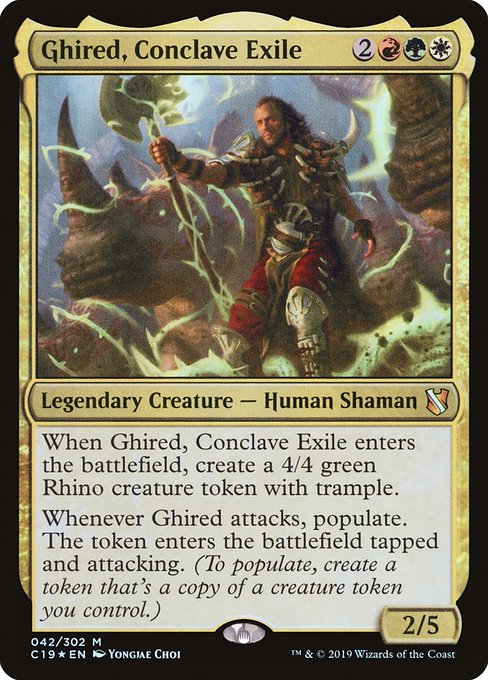
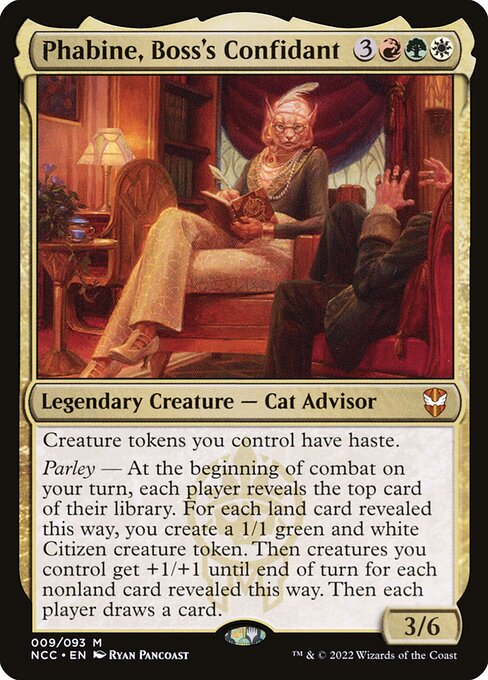

We haven’t talked about the Populate mechanic to this point, but Ghired, Conclave Exile is probably the legendary creature that takes the best advantage of it. Whenever you Populate, you make a copy of an existing creature token. Since Ghired enters the battlefield with a 4/4, you’ll usually have a good one to copy.
It’s surprisingly easy to go bigger though. Giant Adephage makes 7/7s with trample, Omnath, Locus of Rage makes 5/5s that will deal extra damage when they die, and Crested Sunmare makes 5/5s just for gaining life!
Throw in some haste and extra combat steps to get multiple attacks with Ghired and your tokens, and everyone will be shuffling up for the next game in short order.
Don’t want to dig for haste? Want to pump your team while also making tokens? Looking for a way to draw some extra cards? Phabine, Boss’s Confidant gives a token player basically everything they want in a single 6 mana creature.
While Phabine is an ideal finisher, it’s also good for helping you get set up in the midgame. Its card draw effect is shared with the table, so you can create multiple tokens, power existing ones up to start whittling down life totals, or both!
Phabine’s generosity also ensures it isn’t always going to be a priority target – though crafty opponents will let the Parley effect resolve, then kill Phabine at instant speed to strip haste away from newly created tokens in order to prevent them from attacking.
Rin and Seri, Inseparable are an unconventional twist on tribal decks, allowing you to play and receive benefits for playing 2 distinct tribes, Dogs and Cats. As you cast a few creatures and build up the creature tokens you receive for doing so, you’ll be able to deal damage to creatures or players and gain life, often making it difficult to do you any lasting harm.
Plus, they’re adorable. Who wouldn’t want to build a deck around these furry friends?
Best Esper Token Commanders (Alela, Artful Provocateur and Nevinyrral, Urborg Tyrant)
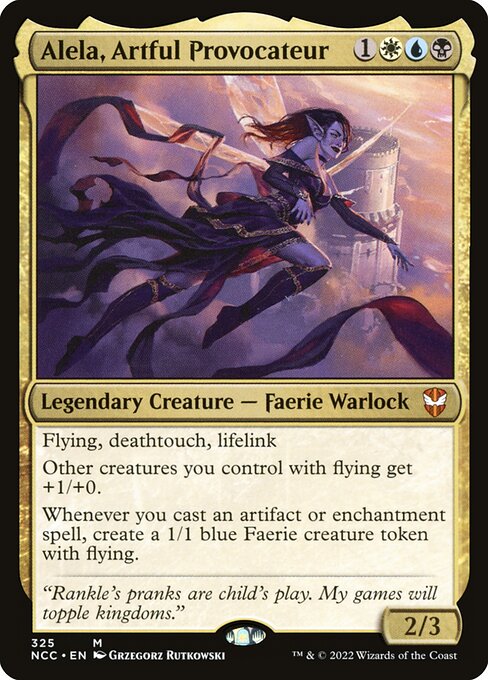
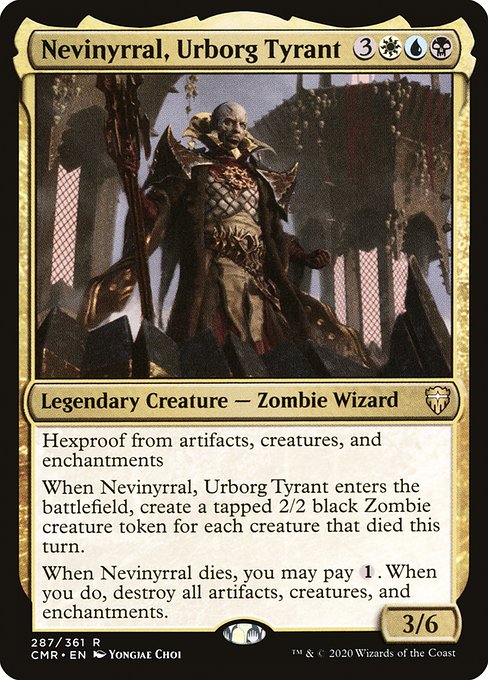
Of the two Esper legendary creatures best suited to token strategies, Alela, Artful Provocateur is easily the more efficient. Receiving free 1/1 fliers for playing artifacts and enchantments in the colors best suited for both of these strategies already offers stellar synergy, and then it boosts all flyers’ power by 1 on top of that.
Nevinyrral, Urborg Tyrant‘s steep mana cost and conditional token generating effect makes it unlikely you’ll be casting it much ahead of the end game, but the sheer number of Zombie tokens it can produce is staggering, especially since it counts all creatures, tokens included.
There are two ways to capitalize on Nevinyrral’s token generation. The first is to set it up with your own board wipe like Damnation and follow up by casting Nevinyrral. This is pretty slow, however, as accumulating 9-11 mana ahead of turn 7-8 is going to be pretty difficult a lot of the time.
My preferred method for using Nevinyrral to create an instant army is finding a way to give it Flash through effects like Leyline of Anticipation or Vedalken Orrery so you can cast it on someone else’s turn, then bring it out in response to another player’s board wipe. Then all you need to do is untap on your turn and swing at your defenseless opponents.
While this strategy is considerably faster due to using less mana, it is worth noting that you’ll be very obviously telegraphing this move once you’re setup, so you’ll need to be prepared for the table to play around it. Fortunately, cards that give all your spells Flash are also ideally suited to this task.
Best Jund Token Commander (Prossh, Skyraider of Kher)
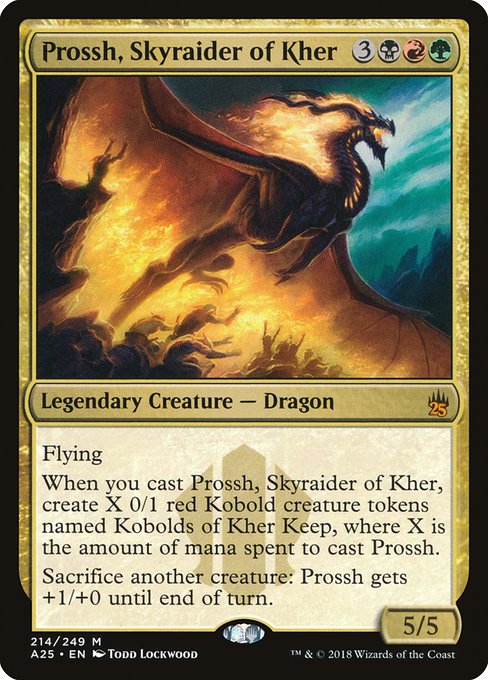
Prossh, Skyraider of Kher was one of the strongest face cards from the early Commander preconstructed decks, and it doesn’t take a lot of digging to see why. Sure, a bunch of 0/1s aren’t going to win the game on their own, but it doesn’t take much to spin them into a host of infinite combos, fodder for Blood Artist and Zulaport Cutthroat, or an instant army with Coat of Arms.
Food Chain is the most common partner in crime for Prossh, generating infinite mana (for creature spells), tokens, and death triggers simultaneously – from there it’s just a matter of choosing how you want to end the game.
Fairer Prossh decks might go the route of Triumph of the Hordes to allow Prossh and/or your army of ankle biters to kill opponents with ease, utilize larger buffs like those offered by Return of the Wildspeaker to get the job done, or use Phyrexian Altar and Ashnod’s Altar to overwhelm the table with powerful spells.
Best Sultai Token Commander (Zaxara, the Exemplary)
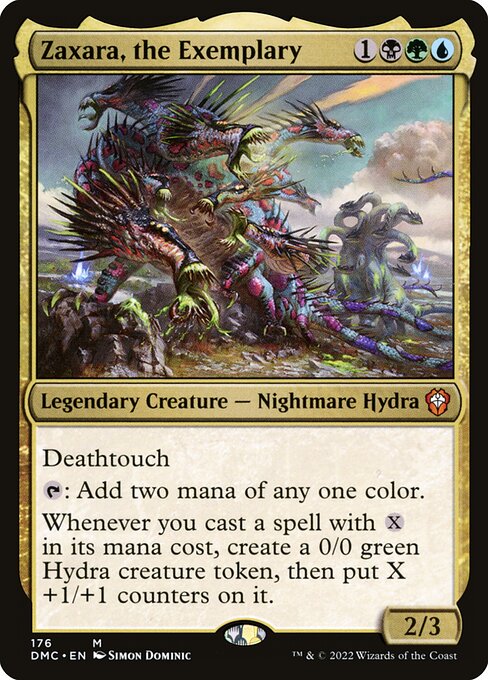
Zaxara the Exemplary is an ideal candidate for “X spells matter” decks, giving you an alternative to Rosheen Meanderer in that space. Unlike Rosheen, however, Zaxara gives you a pretty serious payoff by maxing X/X tokens each time you cast a “X” spell.
When you have access to the best mana ramp, tutors, and card draw effects in the game, it won’t take long to build huge hydras like Hydroid Krasis, token generators like Empty the Pits, or powerful payoffs like Villainous Wealth, all of which can be doubled on the cheap via Unbound Flourishing and will be making huge attackers simply for casting these spells.
And yes, the doubling from Unbound Flourishing makes Zaxara’s tokens even bigger. To say nothing of the fact Zaxara can also kick in 2 mana themselves. It surprises me I haven’t seen more of Zaxara since it came out…right, Commander 2020, pandemic, etc. I foresee a fun deckbuilding project in my future…
Best Mardu Token Commanders (Edgar Markov and Jirina Kudro)
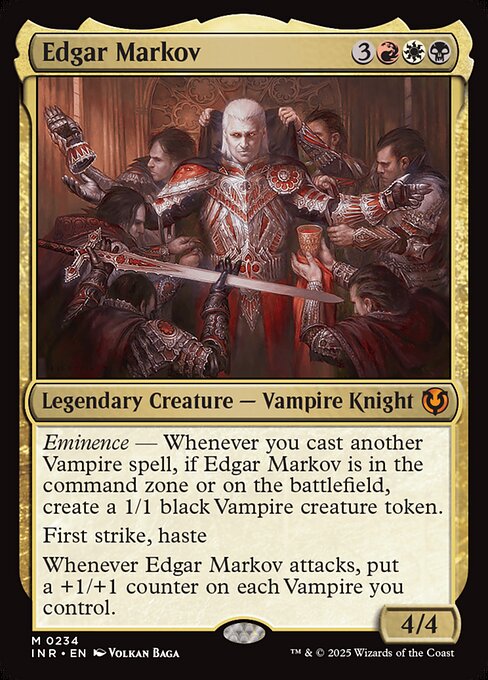
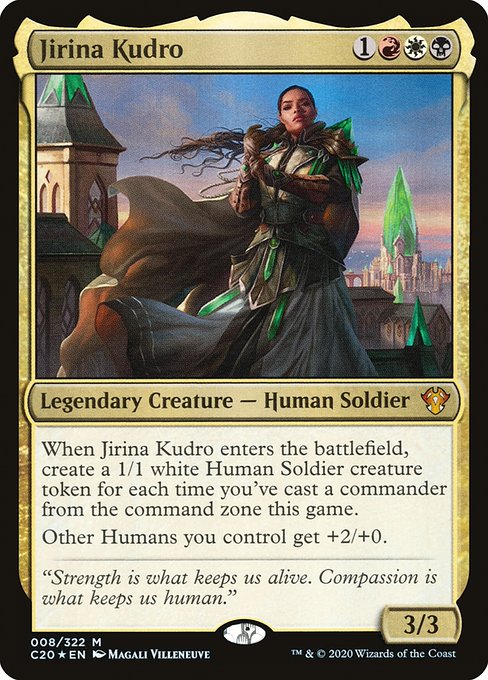
Edgar Markov is a grossly overpowered commander. Eminence is an incredibly strong ability, as you don’t even need to cast this vampire progenitor to make a zillion tokens in Vampire decks. and if for some reason you decide to later in the game, swinging with him boosts your horde of undead the turn he comes down because he has haste.
Jirina Kudro pushes you in the direction of building a Human tribal deck, and there are enough cards in these colors that make tokens to make the whopping payoff of 2 extra power for all other Humans worthwhile. While not nearly as efficient as Edgar Markov, you’ll likely be invited back to your playgroup for another game with Jirina as your commander.
Best Temur Token Commander (Xyris, the Writhing Storm)
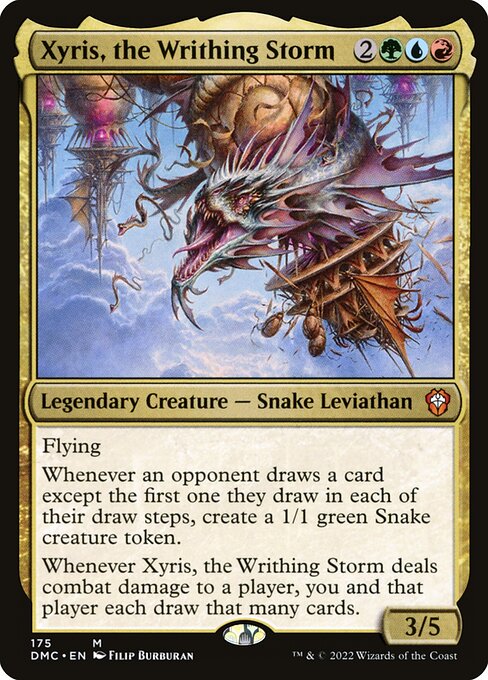
Xyris, the Writhing Storm is another commander that rewards you for making players draw cards, but unlike The Locust God, you’re rewarded for making your opponents draw. Naturally, this makes cards like Diminishing Returns and Wheel of Misfortune quite attractive, but also opens up bonuses for playing cards like Howling Mine and Fevered Visions.
If wheel effects and group hug cards aren’t your forte, you can also choose to focus on finding ways to boost the power of Xyris, then swing in for a bunch of damage in the area to build your swarm that way. Generally, this will be much less efficient, but is completely viable if you wish to build your deck in this direction.
Best Abzan Token Commander (Ghave, Guru of Spores)
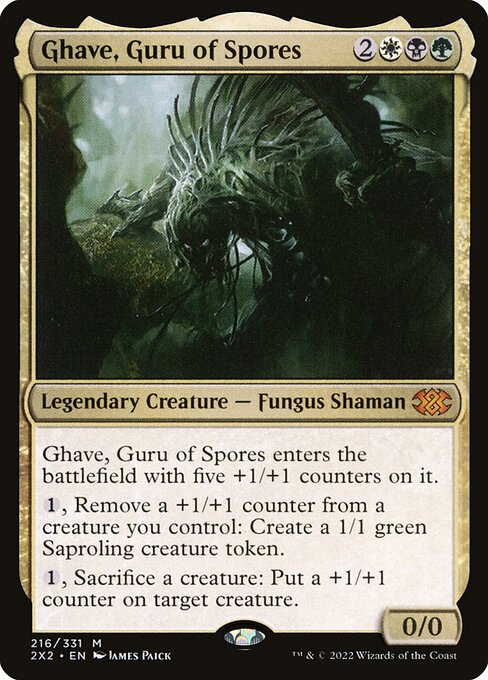
Ghave, Guru of Spores, much like Prossh, Skyraider of Kher, is a combo oriented token deck that can go infinite a ton of different ways. Don’t believe me? This primer showcases just how much nonsense Ghave can enable.
Earthcraft is the best source of mana to fuel a number of infinite combos involving Doubling Season, Cathars’ Crusade, The Meathook Massacre, and Corpse Knight, among others, but these cards only scratch the surface of your combo potential with this commander, so if that’s your preferred style of play, the linked primer above is going to be your best starting point for deck construction.
Best Jeskai Token Commander (Kykar, Wind’s Fury)
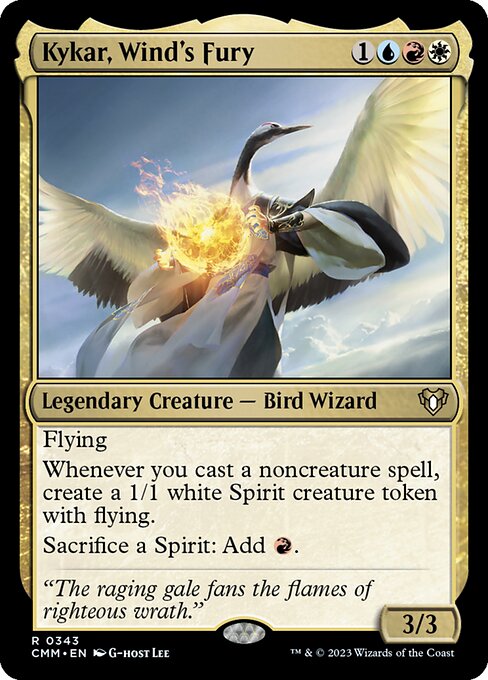
Kykar, Wind’s Fury opens quite a few doors that are closed to mono-blue commanders like Talrand, Sky Summoner with the same style of play. Access to red and white nets powerful payoff cards like Purphoros, God of the Forge and extra redundancy for token generation through cards like Saheeli, Sublime Artificer and Monastery Mentor.
Spirit tokens generated by Kykar or through other effects are especially useful, as they can be turned into red mana to fuel more spells for token generation or more powerful finishing moves.
For those who prefer a combo-oriented style of play, Kykar decks are also well suited to cards with Storm (spells like Empty the Warrens that copy themselves for every other spell cast before them on the same turn) and cards that reward you for playing lots of spells like Aetherflux Reservoir, to say nothing of the other independent combos that synergize with Kykar like Elsha of the Infinite + Sensei’s Divining Top.
Best 5 Color Token Commanders (Sliver Queen and Najeela, the Blade-Blossom)
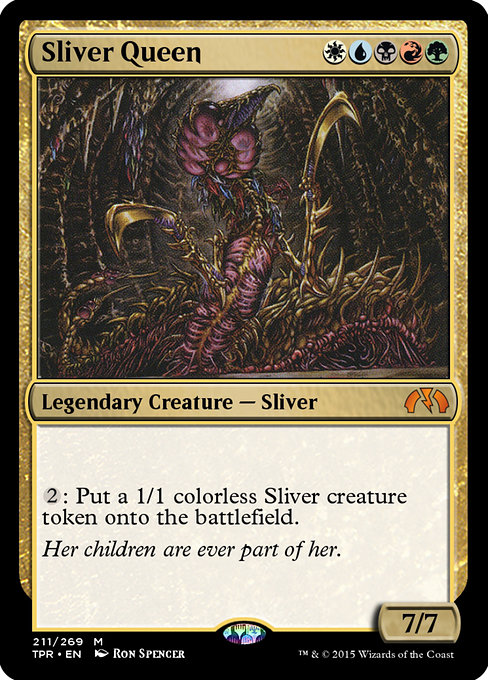
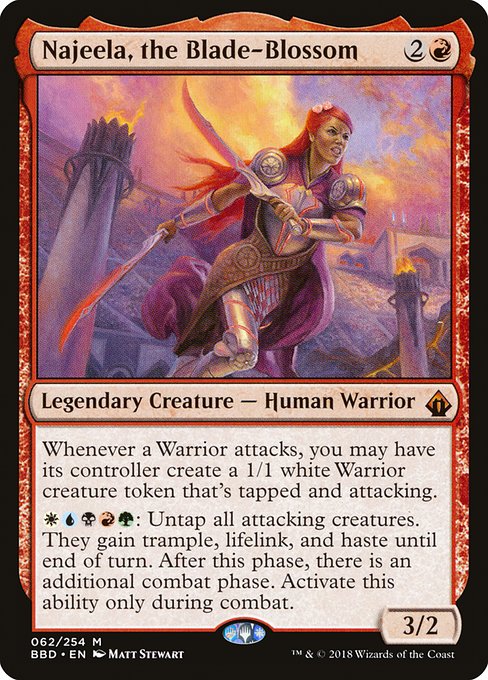
Sliver Queen, while best known for its role in dedicated Sliver decks, is actually able to generate infinite tokens really easily outside that shell. All you need is a card like Heartstone or Zirda, the Dawnwaker to reduce the cost of Sliver Queen‘s effect, then cards like Earthcraft or Gemhide Sliver + a haste enabler, and you have access to infinite 1/1s.
That said, since Slivers give all their buddies a wide array of power boosts, keyword abilities, and effects, you’ll usually be better served by trying to harness these combos with this hivemind to increase your odds of having the right combo pieces when you want them.
Najeela, the Blade-Blossom takes a more hands-on approach to its token generation, allowing you to create 1/1 Warriors each time a Warrior attacks. This often cascades incredibly quickly without any additional help, putting opponents hopelessly behind on a very aggressive clock.
Naturally, this becomes even harder to withstand if you use Najeela’s own ability to start getting extra combat steps and raising your life total by giving your creatures lifelink. If you’d prefer to leave nothing to chance, you can also easily make infinite combat steps by combining cards like Sword of Feast and Famine, Druids’ Repository, or Faeburrow Elder with Najeela’s effect.
Common MTG Token Rulings and Questions
What is a Token?
Rule 111.1 of the MTG Comprehensive Rules indicates a token can be any marker that isn’t represented by a card.
How Do You Get Tokens in MTG?
Tokens are often included in booster packs and preconstructed decks. If you’re looking for a specific token, your friendly local game store will often have a wide selection to choose from.
Do You Need Token Cards in MTG?
Nope! It’s extremely common to use dice, glass beads, or other similar items to serve as tokens.
Do Tokens Go to the Graveyard in MTG?
Yes. When a token dies or is destroyed, it goes to the graveyard, then ceases to exist as a state-based action per rule 111.7 of Magic’s Comprehensive Rules. This also means that abilities that would trigger from a token dying and going to the graveyard will trigger before the token disappears.
This state-based action will occur anytime a token changes zones, so the same will be true if a permanent is bounced back to your hand via Cyclonic Rift or exiled by Path to Exile.
Do Tokens have a CMC (Converted Mana Cost/Mana Value)?
Most tokens have a default mana value of 0. Tokens that are copies of permanents are the exception, taking on the mana value of the permanent they’re copying.
Do Tokens in MTG Have Summoning Sickness?
If they’re creatures, yes. If not, no. All the same rules that govern how regular MTG cards enter play, tap, and attack, including summoning sickness, apply to tokens.
Do Tokens Enter the Battlefield Tapped?
Tokens come into play untapped unless the card creating them states otherwise.
Are Tokens Permanents in MTG?
Yes.
What is a Treasure Token?
A Treasure token is an example of a predefined token from rule 111.10 of the MTG Comprehensive Rules. Here is the full list of predefined tokens and what they do:
- 111.10a A Treasure token is a colorless Treasure artifact token with “{T}, Sacrifice this artifact: Add one mana of any color.”
- 111.10b A Food token is a colorless Food artifact token with “{2}, {T}, Sacrifice this artifact: You gain 3 life.”
- 111.10c A Gold token is a colorless Gold artifact token with “Sacrifice this artifact: Add one mana of any color.”
- 111.10d A Walker token is a 2/2 black Zombie creature token named Walker.
- 111.10e A Shard token is a colorless Shard enchantment token with “{2}, Sacrifice this enchantment: Scry 1, then draw a card.”
- 111.10f A Clue token is a colorless Clue artifact token with “{2}, Sacrifice this artifact: Draw a card.”
- 111.10g A Blood token is a colorless Blood artifact token with “{1}, {T}, Discard a card, Sacrifice this artifact: Draw a card.”
Other MTG Articles You Might Enjoy
- Best Reanimator Commanders in EDH
- Magic’s Best Mana Rocks for Commander
- Spelltable MTG Setup
- Spindown Dice vs d20 Guide
Braden is a founder of Assorted Meeples and has been a gamer & writer with a vivid imagination all his life. Don’t believe us? Check out his excitement when meeting Goosebumps author R.L. Stine as a kid! An avid Magic: The Gathering spellslinger for over 15 years, you can always convince him to shuffle up for a game (or three!) of Commander.

